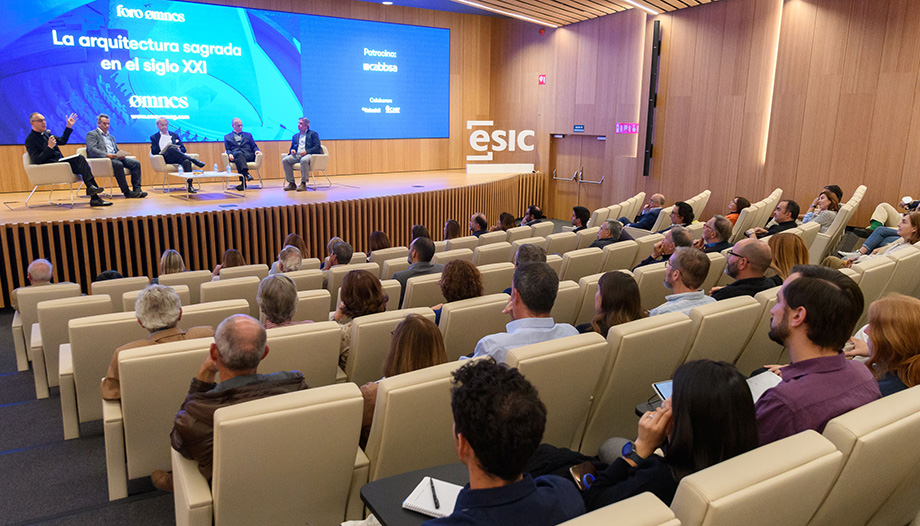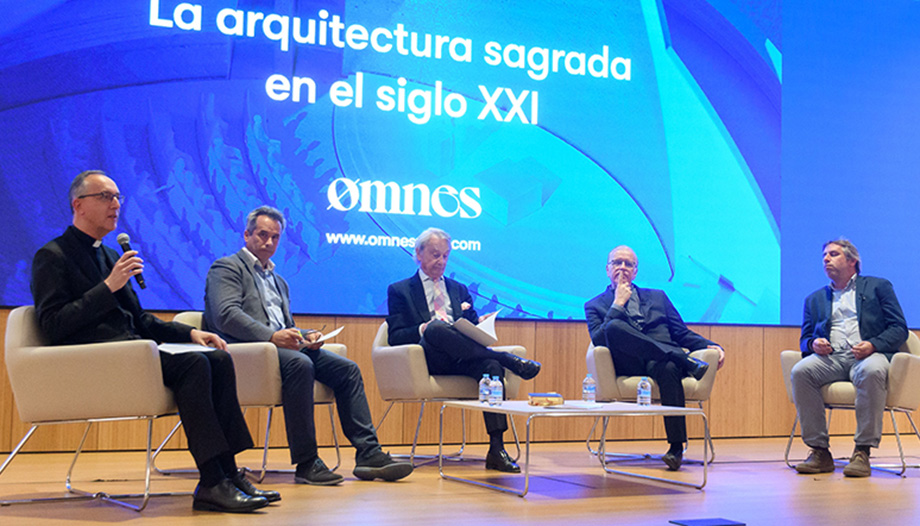 Art, Beauty and God. Gaudí, incarnation of divine beauty.
Art, Beauty and God. Gaudí, incarnation of divine beauty. Pablo Muñoz RuizStained glass windows are jewels that enlighten us".
Pablo Muñoz RuizStained glass windows are jewels that enlighten us". Art to help future artists
Art to help future artistsOn Tuesday, May 16, 2023, the headquarters of the private university ESIC hosted the Omnes Forum on the theme "Sacred Architecture in the 21st Century". The panel, moderated by Mr. Alfonso Riobó, director of Omnes, was formed by architects Felipe Samarán, Ignacio Vicens and Emilio Delgado, and the priest Jesús Higueras, parish priest of Santa María de Caná.
The meeting, sponsored by the construction company CabbsaThe Sabadell bank and the CARF foundation also collaborated in the project.
The event was attended by Jorge Beltrán, president of Cabbsa, Paloma Tejero, vice-counselor of the Regional Ministry of the Environment of the Community of Madrid, and Luis Alberto Rosales, director of the CARF Foundation, among others.
Recovering beauty
Jesús Higueras, pastor of Santa María de Caná, began the interventions by pointing out that, when building a church, the importance of connecting this space with transcendence must be taken into account.
At the same time, he pointed out that the church is not only limited to the temple, but also has to cover other needs related to its evangelizing function, not only celebratory, such as, for example, having rooms for catechesis. Jesús stressed that economic reasons should not lead us to renounce beauty, and he invited us to recover beauty in the construction of churches.
The evolution of sacred architecture
Felipe Samarán then spoke, contextualizing the fact that the church is a place where the attendees ask themselves about the meaning of life and a series of transcendental questions, which must be taken into account when projecting it. "How do you make the eternal message of that which has been given to us coexist with a necessarily outdated wrapping?" he asked.
He also explained that Christ never spoke of liturgy or architecture, and this has evolved over the centuries, but without losing sight of the fundamentals.

In what affects us more closely, he gave the example of the Second Vatican Council: "The altar became a dialogical relationship between the officiant of the Eucharist and the people of God who were attending it, as opposed to what happened before, which was a relationship between all of them looking in the same direction (...) This relationship that is established, now new, is different from the one that existed in the Church that preceded us". Regarding the difficulty involved in the architectural design of a church, he said that "the only solution is to have a Christocentric and objective perspective of what we are doing".
Today's temples represent our time
Thirdly, Emilio Delgado gave his presentation, stressing the importance of professional responsibility, since, when a church is commissioned, "the architect has to make a place to worship God". He explained that "the temple refers to an origin", "it brings together all of history", from the Old Testament to the New, and also "it is the place where we ask ourselves where we come from and where we are going". Finally, he explained that the sanctuaries represent humanity throughout history and that "today's temples represent us".
To know the liturgy
The last speaker, Ignacio Vicens, began the debate by answering one of the questions posed by Jesús Higueras at the beginning of the event: should the architect attend to the sensitivity of the faithful or to beauty and excellence? "Excellence is the only thing that can be offered to God. The sensitivity of the faithful is perfectly irrelevant when speaking of sacred art or sacred architecture," he answered.
He also pointed out that the economic issue is never a problem for architecture, indicating that the best architecture in Spain in the twentieth century was in the 50s, when there were few economic and material means. On the other hand, he asserted that in order to be able to correctly design a church it is essential to study what the Church wants, that is to say, to dominate the liturgy. "Either you master the liturgy perfectly, or you will get it wrong," he assured.
At the end of the colloquium, attendees were able to ask questions to the panel. In the June issue of the magazine we will have an extensive section dedicated to this event.











